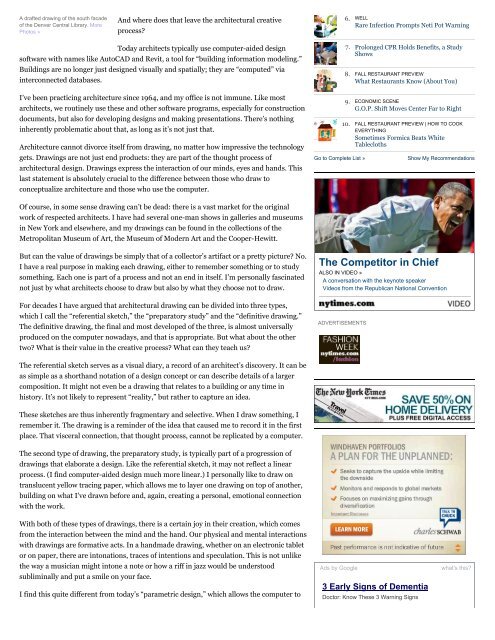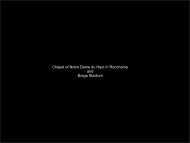Architecture and the Lost Art of Drawing - NYTimes.com - KT Studio
Architecture and the Lost Art of Drawing - NYTimes.com - KT Studio
Architecture and the Lost Art of Drawing - NYTimes.com - KT Studio
Create successful ePaper yourself
Turn your PDF publications into a flip-book with our unique Google optimized e-Paper software.
A drafted drawing <strong>of</strong> <strong>the</strong> south facade<br />
<strong>of</strong> <strong>the</strong> Denver Central Library. More<br />
Photos »<br />
And where does that leave <strong>the</strong> architectural creative<br />
process?<br />
6. WELL<br />
Rare Infection Prompts Neti Pot Warning<br />
Today architects typically use <strong>com</strong>puter-aided design<br />
s<strong>of</strong>tware with names like AutoCAD <strong>and</strong> Revit, a tool for “building information modeling.”<br />
Buildings are no longer just designed visually <strong>and</strong> spatially; <strong>the</strong>y are “<strong>com</strong>puted” via<br />
interconnected databases.<br />
I’ve been practicing architecture since 1964, <strong>and</strong> my <strong>of</strong>fice is not immune. Like most<br />
architects, we routinely use <strong>the</strong>se <strong>and</strong> o<strong>the</strong>r s<strong>of</strong>tware programs, especially for construction<br />
documents, but also for developing designs <strong>and</strong> making presentations. There’s nothing<br />
inherently problematic about that, as long as it’s not just that.<br />
<strong>Architecture</strong> cannot divorce itself from drawing, no matter how impressive <strong>the</strong> technology<br />
gets. <strong>Drawing</strong>s are not just end products: <strong>the</strong>y are part <strong>of</strong> <strong>the</strong> thought process <strong>of</strong><br />
architectural design. <strong>Drawing</strong>s express <strong>the</strong> interaction <strong>of</strong> our minds, eyes <strong>and</strong> h<strong>and</strong>s. This<br />
last statement is absolutely crucial to <strong>the</strong> difference between those who draw to<br />
conceptualize architecture <strong>and</strong> those who use <strong>the</strong> <strong>com</strong>puter.<br />
Go to Complete List »<br />
7. Prolonged CPR Holds Benefits, a Study<br />
Shows<br />
8. FALL RESTAURANT PREVIEW<br />
What Restaurants Know (About You)<br />
9. ECONOMIC SCENE<br />
G.O.P. Shift Moves Center Far to Right<br />
10. FALL RESTAURANT PREVIEW | HOW TO COOK<br />
EVERYTHING<br />
Sometimes Formica Beats White<br />
Tablecloths<br />
Show My Re<strong>com</strong>mendations<br />
Of course, in some sense drawing can’t be dead: <strong>the</strong>re is a vast market for <strong>the</strong> original<br />
work <strong>of</strong> respected architects. I have had several one-man shows in galleries <strong>and</strong> museums<br />
in New York <strong>and</strong> elsewhere, <strong>and</strong> my drawings can be found in <strong>the</strong> collections <strong>of</strong> <strong>the</strong><br />
Metropolitan Museum <strong>of</strong> <strong>Art</strong>, <strong>the</strong> Museum <strong>of</strong> Modern <strong>Art</strong> <strong>and</strong> <strong>the</strong> Cooper-Hewitt.<br />
But can <strong>the</strong> value <strong>of</strong> drawings be simply that <strong>of</strong> a collector’s artifact or a pretty picture? No.<br />
I have a real purpose in making each drawing, ei<strong>the</strong>r to remember something or to study<br />
something. Each one is part <strong>of</strong> a process <strong>and</strong> not an end in itself. I’m personally fascinated<br />
not just by what architects choose to draw but also by what <strong>the</strong>y choose not to draw.<br />
For decades I have argued that architectural drawing can be divided into three types,<br />
which I call <strong>the</strong> “referential sketch,” <strong>the</strong> “preparatory study” <strong>and</strong> <strong>the</strong> “definitive drawing.”<br />
The definitive drawing, <strong>the</strong> final <strong>and</strong> most developed <strong>of</strong> <strong>the</strong> three, is almost universally<br />
produced on <strong>the</strong> <strong>com</strong>puter nowadays, <strong>and</strong> that is appropriate. But what about <strong>the</strong> o<strong>the</strong>r<br />
two? What is <strong>the</strong>ir value in <strong>the</strong> creative process? What can <strong>the</strong>y teach us?<br />
The Competitor in Chief<br />
ALSO IN VIDEO »<br />
A conversation with <strong>the</strong> keynote speaker<br />
Videos from <strong>the</strong> Republican National Convention<br />
ADVERTISEMENTS<br />
The referential sketch serves as a visual diary, a record <strong>of</strong> an architect’s discovery. It can be<br />
as simple as a shorth<strong>and</strong> notation <strong>of</strong> a design concept or can describe details <strong>of</strong> a larger<br />
<strong>com</strong>position. It might not even be a drawing that relates to a building or any time in<br />
history. It’s not likely to represent “reality,” but ra<strong>the</strong>r to capture an idea.<br />
These sketches are thus inherently fragmentary <strong>and</strong> selective. When I draw something, I<br />
remember it. The drawing is a reminder <strong>of</strong> <strong>the</strong> idea that caused me to record it in <strong>the</strong> first<br />
place. That visceral connection, that thought process, cannot be replicated by a <strong>com</strong>puter.<br />
The second type <strong>of</strong> drawing, <strong>the</strong> preparatory study, is typically part <strong>of</strong> a progression <strong>of</strong><br />
drawings that elaborate a design. Like <strong>the</strong> referential sketch, it may not reflect a linear<br />
process. (I find <strong>com</strong>puter-aided design much more linear.) I personally like to draw on<br />
translucent yellow tracing paper, which allows me to layer one drawing on top <strong>of</strong> ano<strong>the</strong>r,<br />
building on what I’ve drawn before <strong>and</strong>, again, creating a personal, emotional connection<br />
with <strong>the</strong> work.<br />
With both <strong>of</strong> <strong>the</strong>se types <strong>of</strong> drawings, <strong>the</strong>re is a certain joy in <strong>the</strong>ir creation, which <strong>com</strong>es<br />
from <strong>the</strong> interaction between <strong>the</strong> mind <strong>and</strong> <strong>the</strong> h<strong>and</strong>. Our physical <strong>and</strong> mental interactions<br />
with drawings are formative acts. In a h<strong>and</strong>made drawing, whe<strong>the</strong>r on an electronic tablet<br />
or on paper, <strong>the</strong>re are intonations, traces <strong>of</strong> intentions <strong>and</strong> speculation. This is not unlike<br />
<strong>the</strong> way a musician might intone a note or how a riff in jazz would be understood<br />
subliminally <strong>and</strong> put a smile on your face.<br />
I find this quite different from today’s “parametric design,” which allows <strong>the</strong> <strong>com</strong>puter to<br />
Ads by Google<br />
3 Early Signs <strong>of</strong> Dementia<br />
Doctor: Know These 3 Warning Signs<br />
what's this?




